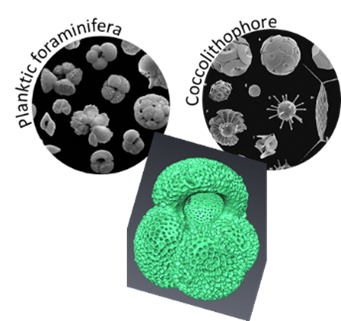The modern marine productivity and species composition are driven by seasonal availability of food/nutrients and environmental conditions1. The calcareous marine productivity is composed of phytoplankton (coccolithophore) and zooplankton (planktic foraminifera) in the present and past. These calcareous marine plankton support the photosynthetic activity, producing oxygen for the planet, and food web. Their diversity patterns and existence are of concern due to changing nutrient availability and ocean stratification in response to anthropogenic climate perturbation2. Climate perturbations has a wide range of biotic response which allows for new ecological opportunities and adaptive strategies. One such global calcareous phytoplankton turnover was during the Pliocene and early Pleistocene3. Study of evolutionary shifts in calcareous phytoplankton and zooplankton morphological characters and/or species composition can provide valuable information about their adaptability in response to climatic perturbations and in assigning climatic factors responsible for those strategic shifts in morphology. This project aims to address key questions: what were the ecosystem response from calcareous phytoplankton and zooplankton to the evolving boundary conditions of the Plio-Pleistocene? What were the adaptive strategies employed by different calcareous plankton? Were these adaptive strategies global or modified in response to regional climate changes?
This project will target tropical ocean, focussing on the Internation Ocean Discovery Programme (IODP) site U1443, across the Plio-Pleistocene (~4-2 Ma) that witnessed evolving climatic conditions observed in atmospheric carbon dioxide (CO2) levels, global cooling in response to northern hemisphere glaciation and associated changes to global circulation and ecosystems4. You will complement, extend and collaborate with ongoing work on Site U1443 exploring phytoplankton morphometric and assemblage data (2.2-2.9 Ma). You will generate new data on planktic foraminifera morphometric and compile additional data from global ocean (Schmidt) to build a comprehensive understanding of the marine ecosystem response for the study interval. You will generate geochemical proxy data (oxygen and carbon isotopes and trace elements) to evaluate changes in water column properties. The study site(s) boast from X-Ray Fluorescence (XRF) elemental ratios and orbitally resolved age model data (unpublished). New records will include planktic foraminifera and coccolithophore morphometrics and assemblage changes to infer ecosystem response along with geochemical proxy data to infer climate.
Figure 1: Photos of calcareous phytoplankton and planktic foraminifera along with an image of computed tomography of planktic foraminifera species.

This project is not suitable for CASE funding
Each host has a slightly different application process.
Find out how to apply for this studentship.
All applications must include the CENTA application form.
Choose your application route
The method will include utilising washed coarse fraction (>150 mm) for picking foraminifera for morphotmetric and geochemical work (oxygen and carbon isotopes measurements) in the fully equipped laboratories at The Open University and University of Bristol. Coarse fraction samples will be used to extend benthic foraminifer oxygen isotope based Pliocene stratigraphy, where applicable. An automated microscopy and computed tomography (CT) scanning will be used to examine the size distribution, morphology, and development of planktic foraminifera (Schmidt). Tooth-pick samples will be used to obtain coccolithophore abundance and morphometric data (Bolton). Further, targeted intervals will be used for multi-species planktic foraminifera geochemical (coupled trace element and oxygen isotope) data to reconstruct water column properties change. Additionally, large data set will be treated for statistical significance to evaluate trend in signal (Holden).
DRs will be awarded CENTA Training Credits (CTCs) for participation in CENTA-provided and ‘free choice’ external training. One CTC can be earned per 3 hours training, and DRs must accrue 100 CTCs across the three and a half years of their PhD.
In addition, the student will receive project specific skills training from supervisors and collaborators: foraminifera taxonomy and morphometrics (Anand, Schmidt), coccolithophore assemblage and morphometrics (Bolton), oxygen isotope and trace elements (Anand), statistical analyses (Holden).
Specific skills that will be acquired during this project include:
This project will benefit from international collaborations and networking opportunities with collaborators working on coccolithophore (Clara Bolton, CEREGE) and planktic foraminifera-based proxies for oceanographic changes (Kate Littler, Exeter) across the Plio-Pleistocene on the IODP projects.
Year 1: Investigate microfossil-based proxy data collection from the selected study site and familiarise with the taxonomy using available training set and atlas. Obtain training in sample processing and automated microscopy and computed tomography (CT) scanning. Obtain preliminary data for the study site and present data at UK-IODP/Paleoclimate Society Meeting.
Year 2: Generate geochemical data after receiving training in geochemical measurements. Obtain micropalaeontological and/or geochemical data from targeted orbital cycles of the Plio-Pleistocene interval. Present data at Pal(a)eoPERCS seminar.
Year 3: Finish remaining analytical work, data analyses, and present results at an international conference and write up thesis and/or prepare manuscript(s).
Students should have a background in Earth science, geography, environmental science, chemistry or similar, and an enthusiasm for palaeoclimate and geochemistry. Experience of labwork and knowledge of organic geochemistry is highly desirable. The student will join a well-established team researching paleoenvironmental change at the Open University. If you would like to apply or require further information please contact pallavi.anand@open.ac.uk
To apply to this project:
Applications must be submitted by 23:59 GMT on Wednesday 7th January 2026.